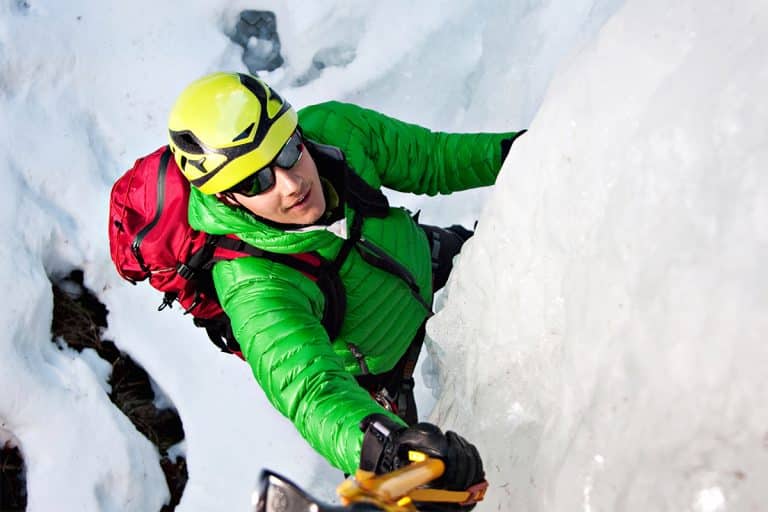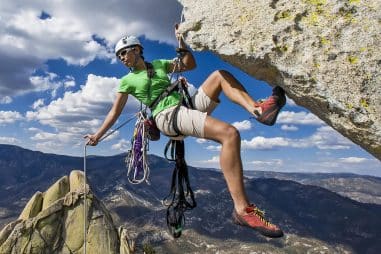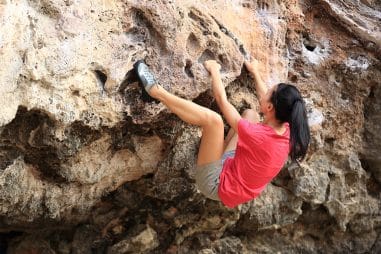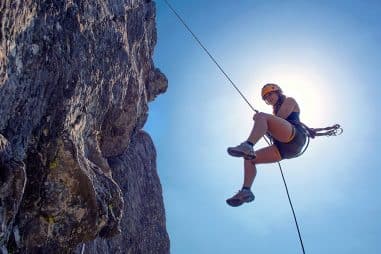There are training courses available for you to take and this will introduce you to the extreme sport of ice climbing. These courses are usually led by a guide to assist you and it’s also a good starting point to get into ice climbing. Additionally, it is also advisable to begin with educating yourself about the wonderful sport of ice climbing so you know what you’re getting yourself into.
What is Snow and Ice Climbing?
Mixed climbing is a form of ice climbing that includes climbing on ice, rock, and snow that is also performed by many flexible ice climbers. Additionally, snow is a highly unstable substance and you must climb it in a completely different manner than when climbing ice.
The extreme sport of climbing up inclined ice formations is called ice climbing. It is just like rock climbing, but climbers ascend frozen water features rather than rocky surfaces. Climbers can ice climb all year round, but this sport is extremely popular during the winter season.
What Do You Do in Ice Climbing?
When you go ice climbing, you work your way up frozen water features such as icefalls, frozen waterfalls, frozen cliffs, frozen rock slabs, glaciers, and many more. This usually involves the use of two ice axes, a few ice screws, some ropes, and crampons toe-in to the ice.
Ice screws are placed by the lead climber as you ascend the wall of ice and ropes are then attached to it. This will serve as protection and keep you safe while you climb upwards.
How Difficult is Ice Climbing?
Ice climbing is a difficult sport not only physically but also mentally. You will need to have a high level of fitness to ice climb but this alone is not enough. You will also need to have the mental capabilities of staying calm under highly stressful conditions given the fact that you might encounter several natural hazards along the way.
What makes ice climbing difficult are the dangers that this activity poses. This is why you shouldn’t underestimate the risks that are involved in ice climbing as this could mean the difference between life and death.
Is Ice Climbing Hard?
There are several factors that make ice climbing hard. No one can tell what might happen when you’re up there which is why you should take into account the several challenges that you will be facing before you go ice climbing.
Ice is not a perfectly smooth, uniform surface and when you touch them, some tend to fall apart. To pick out the right places to step and swing, ice climbing takes a high degree of skill. Similar to rock climbing, ice climbing often involves a high degree of skill to make maximum use of the available features by using balance and position.
Is Ice Climbing Harder Than Rock Climbing?
Even though all you do in ice climbing is use your ice axe to immediately tell whether a hold is good or not, ice climbing is still a lot harder than rock climbing because things can get pretty tricky which demands a high level of technique. In addition to this, it is also more difficult to feel when you have stable feet and fully trust them to carry your weight.
One of the many reasons that make ice climbing harder than rock climbing is because it happens in the extreme cold. In addition to this, it tends to be very wet out there which makes it harder for you to ice climb. You should also be physically fit to be able to carry yourself and your gear all the way to the top.
How Dangerous is Ice Climbing?
Ice climbing is inherently dangerous and is one of the most dangerous forms of climbing. However, just like any extreme sport, the risks that come with ice climbing can be mitigated.
Falling while ice climbing is way riskier than falling while rock climbing. You are able to control the fall in rock climbing. On the other hand, it’s a lot harder for you to control the fall in ice climbing due to all the gear that you’re wearing and this can lead to a great number of injuries.
What is Dangerous About Ice Climbing?
There are a number of hazards to look out for that make ice climbing dangerous, but it is important to remember that all of this can be handled efficiently. Listed down below are some of the several reasons that make ice climbing dangerous:
- Falling: Falling while ice climbing should be avoided no matter what happens. More than having damaged equipment, falling while ice climbing can result in multiple serious injuries such as broken bones, torn cartilages, head trauma, and many more.
- Cold: Although it is possible for you to ice climb all year round, most ice climbing trips happen during winter. You are faced with harsh weather conditions specifically extreme cold and frostbite can happen within a matter of minutes if you are not appropriately dressed with the right climbing gear.
- Falling Debris: This is not uncommon when you go ice climbing. Ice can break and fall apart when you go ice climbing. Although you cannot stop pieces of ice from falling, you can always make sure to avoid it so it doesn’t hit you or if you’re leading, ensure that you warn the people beneath you of falling ice.
- Avalanche Risk: Avalanches are unpredictable and they surely can happen without warning. It is extremely dangerous when avalanches occur. It will send tons of snow down your way which can pull you off the wall, bury you, or even cost you your life.
- Weather Conditions: Ice climbing happens outdoors, usually in the middle of winter. You’re confronted with freezing temperatures and sometimes in an environment where the weather can change in the blink of an eye, triggering several natural disasters such as storms or cold fronts.
Is Ice Climbing More Dangerous Than Rock Climbing?
As mentioned earlier, falling while ice climbing is far more dangerous than falling while rock climbing and it should never be an option most especially when you’re leading. It is much harder to take a clean fall when ice climbing due to all the gear that you’re wearing unlike when rock climbing.
When it comes to ice climbing, the possibility of being injured is smaller, but it is riskier. It is highly beneficial to acquire extensive training before you go on an ice climbing trip as this will greatly reduce the dangers that come with the sport. The way you ice climb determines your exposure to danger, and it can be just as safe as a walk in the park.
How Do You Fall in Ice Climbing?
There is no proper way of falling when ice climbing and you most certainly cannot practice it. Seldomly can all four limbs come off the ice at the same time during ice climbing and this can result in severe injuries which might make it impossible for you to climb ever again. All you can do is give it your all to avoid the risk of falling at all costs.
In the event that you fall, you can yell “Falling!” to warn the people beneath you to catch you and avoid injuring them. As opposed to falling while rock climbing, falling while ice climbing is hard to control and it is much difficult to take a clean fall. This is why you should do everything in your power to avoid falling while ice climbing.
Is Ice Climbing an Extreme Sport?
Ice climbing has been just another aspect of rock climbing and other mountaineering activities for many years. It is now considered an extreme sport because of the conditions in which ice climbing usually takes place.
You are literally climbing on water that is frozen and it is not the most stable environment. Additionally, you have two lethal objects: the ice axe on your hands and the spikes on your shoes. In the event that you fall, these can severely injure you.
How Are Ice Climbs Graded?
Ice climbs are graded based on their steepness and the type of ice. An ice climbing route may have a different grade after a year has passed since ice is constantly changing. Three grading systems are used in the United States to calculate climbing on three distinct types of ice:
- Water Ice (WI): is ice that melts during the hotter months of the year or seasonal ice. The scale ranges from WI1 to WI7:
- WI1: Low-angled ice that is easy to climb. No tools are needed. The general angle is 50 degrees.
- WI2: Moderate low-angled ice (consistent 60 degrees ice). You can easily climb this with a single ice axe and good technique. Grades above this usually need the use of two ice axes.
- WI3: Steeper water ice. Sustained 70 degrees with a few tiny vertical steps up to 4 meters and longer bulges of 80 to 90 degrees. The climb generally has reasonable rests and good protection.
- WI4: Continuous 80-85 degree climbing with small vertical steps of up to 10 meters. Protection screws must be placed from difficult stances.
- WI5: Long, steep, strenuous ice. Nearly vertical or vertical steps of up to 20 meters with a few good rests.
- WI6: Long sections of sustained 90 degrees vertical climbing for the entire pitch with no opportunities to rest. Highly technical climb.
- WI7: Long, overhanging ice with no opportunities to rest. Poor quality ice that is difficult or impossible to protect. Requires a high level of physical fitness. The general angle is 90 degrees above.
- WI8: Currently under discussion.
- Alpine Ice (AI): is permanent ice that is commonly located in high altitudes or glaciers that do not thaw completely. Alpine ice may be easier to climb than water ice but it is harder to reach because of the remoteness of its location and its exposure to avalanche danger. Just like with water ice, the scale ranges from AI1 to AI7, but the prefix is A instead of W.
- Mixed Ice (M): routes that contain ice but are partially rock as well. The scale ranges from M1 to M13:
- M1-M3: Extremely easy, low-angled rock and ice. Usually, no tools are needed for you to make the climb except for crampons. You will mostly be doing a lot of scrambling than mixed climbing. Equivalent to 5.5 to 5.7 rock climbing grade.
- M4: Low, moderate climbing. Near vertical or to vertical with the use of ice axes and crampons. Equivalent to 5.8 rock climbing grade.
- M5: Sustained vertical mixed climbing. The use of your crampons will be highly advantageous in finding a stable foothold. Equivalent to rock climbing grade of 5.9.
- M6: Vertical to overhanging with difficult dry-tooling. Equivalent 5.10 rock climbing grade.
- M7: Long, overhanging terrain. The use of powerful and technical dry-tooling is mandatory. Equivalent to 5.11 rock climbing grade.
- M8: High moderate climbing. Nearly horizontal sustained, overhanging climbing. Has longer cruxes than M7. Equivalent to 5.11+ rock climbing grade.
- M9: Continuous long, vertical climb with highly technical holds. Equivalent to 5.12- rock climbing grade.
- M10: At least 10 meters of horizontal rock or 30 meters of overhanging dry tooling with powerful moves and no rests. Equivalent to 5.12 rock climbing grade.
- M11: Anything above M10 is advanced climbing. Either a full ropelength of overhanging gymnastic climbing or up to 15 meters of roof. Equivalent to 5.12+ rock climbing grade.
- M12: An M11 climbing route with even harder strenuous holds and more difficult moves. Equivalent to rock climbing grade of 5.13
- M13-M16: These climbing routes are the highest degree of mixed climbing difficulty. Even experts do not exactly know how hard these climbing routes are and what they feature.
Listed down below are the several different factors that must be taken into consideration when grading an ice climb:
- Length of time that it will take to ascend
- How steep the ice is
- The technical skill necessary to make the ascent
- The ice quality
- The number of areas covered or exposed on the route
- Protection availability
- The degree of risk involved in climbing
- Availability of resting points
- Equipment required to make the climb (if any)
- The technicality of the movements:
- Level of difficulty in locating the route
- Level of difficulty and number of pitches
- Altitude
Where Did Ice Climbing Originate?
Ice climbing began in Europe back in the 19th Century but only as an aspect of mountaineering. In 1908, the English engineer Oscar Eckenstein developed a type of claw tooth that was attached to the bottom of a boot. This was the first crampon and the first major advancement in the sport of ice climbing.
In 1912, the first known ice climbing competition was held on the Brenva Glacier. This took place in Courmayeur, Italy.
Who is the Best Ice Climber in the World?
Ines Papert is considered as one of the best ice climbers in the world. She is a German professional ice climber. She is a world champion ice and mixed climber well-known for her ice climbing competition awards and difficult alpine ascents.
She won the overall Ice Climbing World Cup in 2006 and has won the World Cup three more times over the years. She made the first ascent of Likhu Chuli in Nepal which was 6719 meters tall on November 13, 2013, and reached the summit all by herself. Moreover, Ines Papert was the first woman to climb the mixed grade of M11.
How Do You Get Into Ice Climbing?
As mentioned earlier, it is best to start by acquiring proper training and educating yourself about the wonderful sport of ice climbing. You should also know what you are getting yourself into before you go on your first ice climbing trip. Just like any extreme sport, ice climbing presents many dangers and it is extremely important that you are aware of them.
You may want to borrow or rent gear for your first ice climbing trip. However, it is highly beneficial to invest in high-quality ice climbing gear if you plan to do a lot of climbing as you will be using this for years.
How Do You Train for Ice Climbing?
Here are some tips on how you should train for ice climbing:
- Determine Your Readiness: Consider visiting your doctor and your psychologist to help you in preparing for a fitness regime. Ice climbing is a physical and psychological sport which is why it is essential to train both the mind and the body. You can start making a training schedule once you have assessed your capabilities.
- Make a Training Schedule: Take time to decide when your training days are before you make your training schedule. Know what days are best for you to train or if you have a training partner, coordinate with them, and know what works for both of you. Avoid overworking yourself so you don’t end up sick and too exhausted to be unable to train at all.
- Plan Your Workouts: The best types of exercises are the ones that you enjoy the most doing. Begin with as little as 20 minutes per exercise and slowly increasing the session per workout would be smart. Gym climbing and home training go hand in hand which is why it is also highly beneficial to train at least twice a week in the climbing gym for 1-2 hours to enhance your climbing techniques. Again, know what works best for you and your partner.
- Fuel Your Body with Proper Nutrition: In order to maintain your physical and mental health and well-being, eating a healthy balanced diet accompanied by regular exercise is necessary. Fueling your body with the proper nutrients will help you achieve the best results.
How Can I Practice Climbing at Home?
You can have a rock climbing wall installed at your home so you won’t have to go out to the gym anymore, but you will surely need a lot of space and money if you want one as big as the walls in the climbing gym. You can also use a hang board, a door frame, or a pull-up bar to strengthen your forearms as well as your fingers.
These tools are not always accessible to most people. Thankfully, there are several simple exercises that you can do to practice climbing in the comfort of your own home. Here’s a list:
- Strengthening your grip strength and wrist mobility
-
- Crow Pose
- False Grip Hang
- Dead Hang
- Sledgehammer/Barbell/Heavy Bar Levering
- Plate curls
- Plate pinches
- Dumbbell Farmer’s Walk
- Deadlift
- Wrist Curls
- Improving your lock-off strength
-
- Banded or Weighted Pull-ups
- Banded Archer Pulls
- One-arm Pull-up
- Vertical Pulls
- Horizontal Pulls
- Tricep Dips
- Pulley Sprain Prevention
- One-arm lock-off
- Frenchies
What Gear Do You Need for Ice Climbing?
Technical gear is required for ice climbing. You need the appropriate equipment to protect you from freezing temperatures and to do the climb itself. Here’s a list of ice climbing essentials:
- Ice Axes
- Ice Screws
- Quickdraws
- Harness
- Slings
- Cordelette
- Carabiners
- Belay device
- Crampons
- Rope
- Clothing
- Helmet
- Headlamps
- Gore-tex Gloves
- Insulated Ice Climbing Boots
- Sunglasses
- Sunblock
- Water Bottle
- Backpack
Depending on where you climb and how long you are going for, what you need to bring on an ice climbing trip differs. Don’t forget to consult with your guide on what you need to bring before heading out to your climbing destination.
What Do You Wear for Ice Climbing?
Here’s a list of what you should wear for ice climbing:
Head:
- Helmet
- Warm hat
- Neckwarmer
- Sunglasses
Top:
- Base layer (made from merino wool)
- Insulating layer
- Down coat/sweater
- Outer layer (softshell/hardshell jacket)
- Belay jacket
Hands:
- 2 pairs of mid-weight to expedition-weight liners
- 2 pairs of waterproof gloves
Bottom:
- Harness
- Wool or synthetic underwear
- Gaiters
- Softshell pants
Feet:
- Thick wool socks
- Snow gaiters
- Ice climbing boots
- Gaiters
Layering is key when dressing up for an ice climbing trip because this extreme sport usually takes place in extremely freezing temperatures. Avoid wearing cotton because it can get easily wet and make you cold instead of warm. How you layer your clothes can make a huge difference in how you climb.
What Are Ice Climbing Shoes Called?
Ice climbing shoes are called mountaineering boots. Mountaineering boots are ideal for ice climbing because they provide stiff soles that enable you to stand comfortably while on the wall, a thermal lining that keeps your feet warm inside your boots, and lots of support for your ankles. This is the reason why your regular hiking boots or winter boots will not do the job.
Mountaineering boots are usually made out of leather, plastic, or synthetic material. These boots come with grooves in the rubber soles where you attach the crampons in place. Crampons are devices with sharpened steel spikes that help you gain traction.
How Should Ice Climbing Boots Fit?
Ice climbing boots should cup your heel comfortably without banging your toes against the front of your boot when you kick. You can conduct some tests to see whether your ice climbing boots fit well.
Most climbing shoe brands have guidelines when you’re choosing the right ice climbing boots for you. Depending on the shape of your foot, the socks you’ll be wearing, and the particular boot model you’re looking for these guidelines will also change.
How Do Ice Screws Work?
Ice screws prevent climbers from falling. As climbers go up the wall, ice screws are placed at regular intervals and a rope is then attached to it. This holds the climber in the event of a fall.
Placing ice screws is one of the greatest challenges of leading ice. Studies show that placing an ice screw upward as high as you can is strongest in good ice and it protects the climb better however, it is important to note that placing ice screws perfectly are extremely rare. How you place ice screws also depends on the way you climb.
What Length Ice Screw is Best?
For extra measures, it is highly advisable that you bring multiple lengths all the time. It is best to know and understand ahead of time what type of conditions you’re going to be dealing with. This will greatly help in assuring that you bring the best length for the route that you will be climbing.
Choosing the best length(s) of your ice screw depends on the difficulty of the route you’re climbing. When choosing the best length(s) of ice screws to bring, keep in mind that the length(s) you need depends on two things. The ice thickness and ice quality.
How Many Ice Screws Do I Need?
Remember that there are various factors that you must take into consideration when deciding the precise number of ice screws to bring in your ice climbing trip. This involves the quality and thickness of the ice. It is recommended to bring at least 7 or 8 ice screws of different lengths.
Due to the fact that ice is unpredictable and constantly changing, having various lengths of ice screws with you will be incredibly helpful as you will be dealing with different ice thicknesses and qualities. In addition to this, you must also keep in mind that you bring just enough for you to get by and no more than that.
Where Do I Ice Climb?
There are countless spots in the world to ice climb. Below is a list of some of the most mesmerizing ice climbing places in the world:
- Rjukan in South Norway
- Canmore in Alberta, Canada
- Kandersteg in Switzerland
- Svínafellsjökull Glacier in Iceland
- Vatnajökull Glacier in Iceland
- Helmcken Falls in British Columbia, Canada
- Cogne in Aosta Valley, Italy
- Viedma Glacier in Argentina
- Johnston Canyon in Banff, Canada
- Fox and Franz Josef Glaciers in West Coast, South Island, New Zealand
Where Can I Ice Climb in the Us?
Ice climbing is a famous winter activity in the United States. All over the country, the United States has plenty of world-class ice-climbing spots, each with its own unique, iconic routes that are definitely worth climbing. Here are some of the best places to go ice climbing in the United States:
- Sandstone Ice Park in Minnesota, USA
- Frankenstein in Crawford Notch State Park, New Hampshire, USA
- Mammoth Lakes in Mono County, California
- Ouray Ice Park in Colorado, USA
- Sandstone Ice Climbing Park in Minnesota, USA
- Keystone Canyon in Alaska, USA
- Provo Canyon in Wasatch Mountains, Utah, USA
- Lake Willoughby in Willoughby State Forest, Vermont, USA
- Peabody Ice Climbing in Fenton, Michigan, USA
- Hyalite Canyon in Bozeman, Montana, USA







